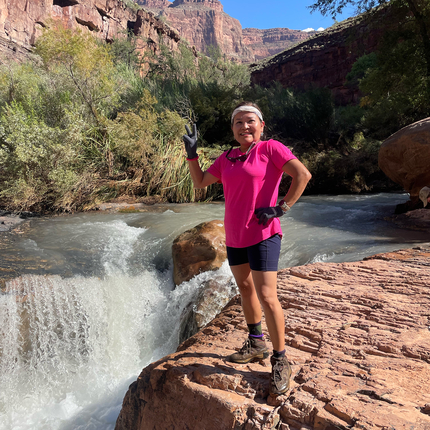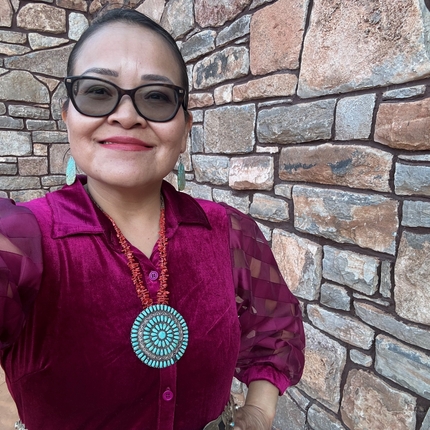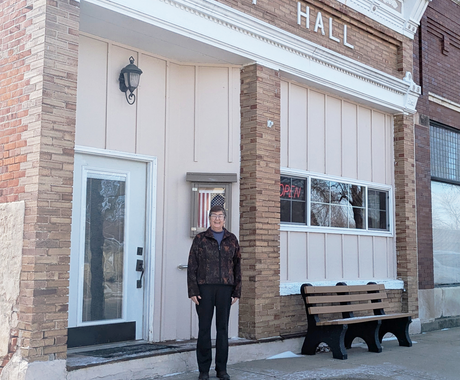Anna Johnson contributed to this story.
In everything she does, Dr. Karletta Chief strives to build a better future.
Raised on the Navajo Nation, Dr. Chief learned strength and endurance from her parents and grandmother. The first person in her family to attend college, Dr. Chief is now the director of the Indigenous Resilience Center at the University of Arizona, in Tucson, and leads efforts that lift up Indigenous scholars and trains the next generation of researchers and leaders. Beyond her academic duties, she is a wife and mother of three children, including a special needs child. She always keeps her community at heart and volunteers at a community based organization called Black Mesa United-Dziłijiin Bee Ahota’, Inc.
Throughout the COVID-19 pandemic, her and her team were members of the Navajo Nation Water Access Coordination Group and worked to do relevant research that could bring insight to COVID-19 impacts on the Navajo people and their access or lack thereof to food, energy, and water. Dr. Chief continues to foster relationships with Tribes and the Indigenous Resilience Center to make research accessible to Tribes.
Because of Dr. Chief’s passion for protecting the environment and work to support and encourage future generations of environmental leaders, she was chosen to receive the 2023 Environmental Leader Award.
This award honors accomplished leaders in the field of environmental stewardship, and recognizes individuals with a proven track record and promise of future advancement in the field. The awards are an independent project administratively supported by the Center for Rural Affairs and made possible by the Walton Family Foundation.
Rural community in Black Mesa
Receiving this award has allowed Dr. Chief to commit more of her focus and resources toward another cause that hits close to home—striving to improve conditions in her home community, Black Mesa, Arizona.
“Black Mesa is a beautiful, pristine area on the Navajo Nation,” she said. “It’s very different because it's on a higher plateau and gets more rain, so there’s more lush vegetation. You can see and enjoy the trees, deer, and elk; there’s lots of wildlife and biodiversity.”
Around 2,000 people live across the plateau. Communities across the area are very rural and many engage in traditional livelihoods such as farming, ranching, and living the Navajo cultural way of life.
Black Mesa has been Dr. Chief’s family’s home for generations. The land is also the site of extensive coal mining.
Starting in the 1960s and ending only within the last decade, the mining created environmental and health impacts for the Navajo people who live there. They also received no financial benefits in exchange for the coal taken from their land. Dr. Chief has made it her goal to develop resources that will benefit future generations in Black Mesa.
For several years, Dr. Chief has served as a leader and board member for the nonprofit grassroots organization Black Mesa United. This organization was created to support the general welfare of Navajo people living in the area where coal mining was most prevalent, as well as to improve, heal, rejuvenate, and protect reclaimed and undisturbed lands in an environmentally sustainable manner.
“I saw the mining impacts and how they affected my family,” said Dr. Chief. “Seeing that environmental injustice motivated me to go into environmental engineering and science in college and work toward justice for my community.”
One of the many projects she’s working on with the Tribal government of the Navajo Nation is to secure funding to convert a mine building that they no longer occupy into a community resilience hub. The goal is to provide a convening space to provide resources for education, health, and business.
“Currently, some services are a 50 to 100 mile round trip, and converting this building to a community center would allow for a space to provide educational, environmental, health, and wellness services to the community,” Dr. Chief said.
Creating opportunities for the Indigenous environmental leaders of tomorrow
Much of the rest of Dr. Chief’s time has been dedicated to working with other faculty and staff at the University of Arizona to provide students with the tools they need to move environmental justice work forward.
Dr. Chief aims to bring relevant water science to Native American communities in a culturally sensitive manner. She co-founded the Indigenous Resilience Center, a unique center created three years ago to support Tribal environmental resilience. As director, Dr. Chief endeavors to open the door for the efforts of the University of Arizona climate/environment researchers, faculty, staff, and students who are working with Native Nations to build resilience to climate impacts and environmental challenges.
The work done at the Indigenous Research Center focuses on community building, research, and teaching. The mission is to center Indigenous ways of knowing into co-designed environmental solutions and training the next generation of community leaders.
Faculty and staff partner and collaborate with Tribes as well as teach science, technology, engineering, and mathematics (STEM) courses that are specifically geared toward community-driven Tribal research, natural resources management, traditional agriculture, Indigenous data sovereignty, and Tribal environmental health, among others.
Research is focused on resilience in Indigenous communities, including sustainable solutions, renewable technologies, solar energy, water treatment, horticulture and small-scale farming, food sovereignty, regenerative agriculture, drought resilience, Native plant restoration, ecological restoration, and more.
“The Indigenous Resilience Center is the University of Arizona’s commitment to giving back to local Tribes who have stewarded this land for millennia,” said Dr. Chief. “We’re faculty that work with communities in the state of Arizona to improve the environment, change behavior, and increase the economy of the state. Our mission is to connect science with community.”
All of this work is framed according to their values and the four Rs: relationship, reciprocity, respect, and responsibility. Faculty, staff, and students center their values in their work with Tribal communities and want to sponsor a relationship that builds trust.
“Our vision is Indigenous communities leading the problem of solving environmental challenges that they see,” said Dr. Chief. “We want to support Indigenous communities in addressing those challenges as well as supporting the new generation of environmental leaders.”
Dr. Chief feels there are many opportunities for Native leadership through different pathways in the academic world like studying environmental science, policy, law, as well as working on the ground as environmental justice activists collaborating with communities firsthand.
“In academia, it’s challenging to find support for that kind of work, so we have to identify programs and universities that have communities and projects that are supporting environmental justice work in Tribal communities,” she said.
For that reason, among others, Dr. Chief is grateful for receiving the Environmental Leader Award, as it has helped move this work forward. She’s also enthusiastic about the projects others are doing in environmental justice work.
“It’s very inspiring to hear and learn from other awardees,” she said. “Seeing the impact of the award in other communities is very uplifting and it’s an honor to be part of that cohort.”
To learn more about the Environmental Leader Awards, visit cfra.org/environmental-leader-awards.






